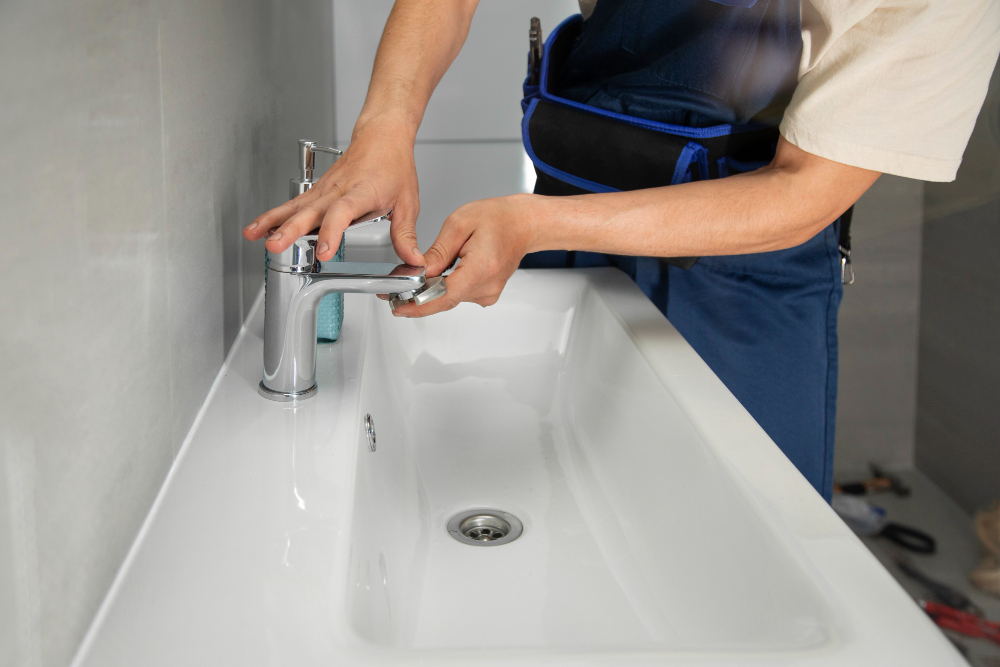Are bathroom faucets universal?
If you’ve asked yourself this question, then this article is for you.
This guide discusses the different types of bathroom sink and faucet types, plus their pros and cons.
If you’re considering fancy faucets for bathroom aesthetics, this blog is also applicable to you.
Table of Contents
ToggleTypes of Bathroom Sink Faucets and Their Pros & Cons

When selecting a bathroom sink faucet (or even a bathroom vanity with a faucet), it’s crucial to consider the specific type that best fits the intended installation space and complements the bathroom design.
For your easy reference, here are different bathroom sink faucet types:
Matte Black Bathroom Faucet
Suitable for modern bathroom decor, offering single-handle control for easy temperature adjustment.
- Pros: Stylish matte black finish adds a bold, contemporary look to the bathroom.
- Cons: May show water spots and fingerprints more easily than other finishes.
Single Hole Faucets
Ideal for small bathrooms, they offer excellent temperature control and require only one hole in the sink or countertop.
- Pros: Ideal for small bathrooms, provide excellent temperature control.
- Cons: May not be suitable for larger sinks.
Centerset Faucets
Require enough space for a 4-inch center hole and are available in single or double-handle options.
- Pros: Versatile in terms of functionality, added features, and design.
- Cons: Require specific hole configuration.
Widespread Faucets
Comprising three separate pieces, with handles and spout mounted separately, they need three holes in the sink or countertop and come in various handle configurations.
- Pros: Offers versatility in overall bathroom design and usage.
- Cons: Require three holes in the sink or countertop.
Vessel Faucets
Specifically designed for vessel sinks, they are typically taller to accommodate the sink’s height.
- Pros: Stylish, can be a focal point, and offers a variety of design options.
- Cons: They may require a specific type of faucet and can be more prone to splashing.
Wall-Mounted Faucets
Mounted on the wall above the sink, they necessitate a separate valve and drain assembly and suit contemporary or minimalist bathroom designs.
- Pros: Great look, easier to keep clean, frees up countertop space.
- Cons: More complicated to change or retrofit as the plumbing is entirely in a wall.
Bridge Faucets
Combining old-fashioned style with modern technology, levers and the faucet branch off from a singular part, requiring two holes in the bathroom countertop.
- Pros: Combine old-fashioned style with modern technology, with the levers and the faucet all branching off of one singular part. They require two holes in the bathroom countertop.
- Cons: May have a higher upfront cost and can be more challenging to install due to the bridge configuration.
Sprinkle Faucets
Offering a unique and noteworthy design, they provide various options for different bathroom styles.
- Pros: Offer a unique and noteworthy design, providing a variety of options for different bathroom styles.
- Cons: The distinctive design may not appeal to everyone, and finding compatible accessories can be more challenging.
Touchless Faucets
Designed for one-hole sinks, these faucets offer a convenient and hygienic option for handwashing.
- Pros: Convenient and hygienic option for handwashing.
- Cons: Require a one-hole sink, may be more expensive.
Types of Bathroom Sinks and Their Pros & Cons
Different types of bathroom sinks have various functions and aesthetics. Here are some common bathroom sinks for your reference:
Vessel Sinks
Mounted on the countertop, these sinks create a floating effect and are available in materials like glass, ceramic, or stone, suitable for various faucet styles.
- Pros: Stylish, can serve as a focal point, and provides various design options.
- Cons: May require a specific type of faucet and can be more prone to splashing.
Undermount Sinks
Installed beneath the countertop, they offer a seamless and modern look, often made of stainless steel or granite. Specific faucets, like bridge faucets, are needed to clear the high rim.
- Pros: Easy to clean, offers a seamless look, and boasts durability.
- Cons: May be more expensive to install and could be challenging to replace.
Drop-In Sinks
Also known as self-rimming, they are placed into a pre-cut hole in the countertop. Available in materials such as porcelain, stainless steel, or acrylic, they pair well with various faucet styles.
- Pros: Easy to install, offer diverse design options, and are cost-effective.
- Cons: More prone to collecting grime around the edges.
Integrated Sinks
Made from the same material as the countertop, these sinks offer a seamless appearance. Typically crafted from solid surface materials like quartz or granite, they require specific faucets, such as wall-mounted, to clear the high rim.
- Pros: Provide a seamless look, easy to clean, and offer a modern appearance.
- Cons: May be more expensive and challenging to replace.
Pedestal Sinks
Mounted on a pedestal, these sinks provide a classic look, usually made of porcelain or ceramic. Specific faucets, like wall-mounted, are required to clear the high rim.
- Pros: Save space, offer a classic look, and are easy to clean around.
- Cons: Provide limited counter space and storage.
Key Takeaway
Selecting the right bathroom sink and faucet involves weighing the pros and cons.
Single-hole faucets offer control but may not suit larger sinks, while widespread faucets bring versatility but need three holes.
Vessel faucets are stylish but may splash, and wall-mounted options free up space but can be challenging to retrofit.
Ultimately, choose based on your space and style preferences.


